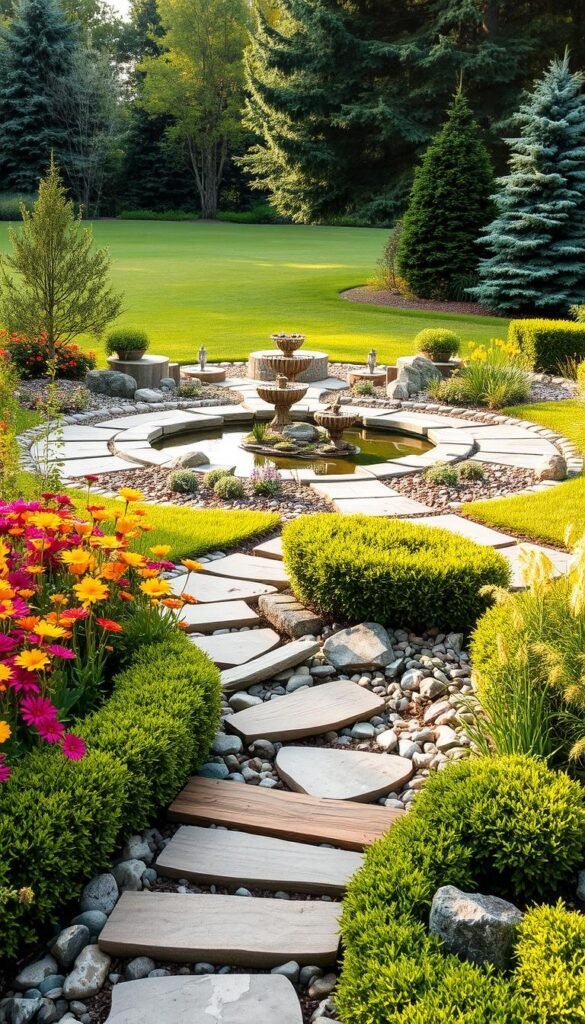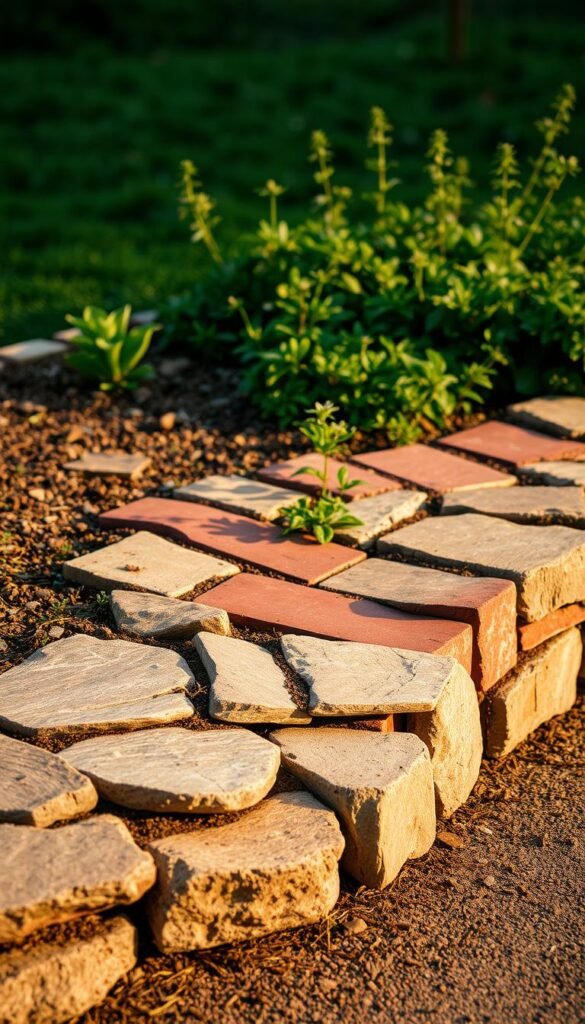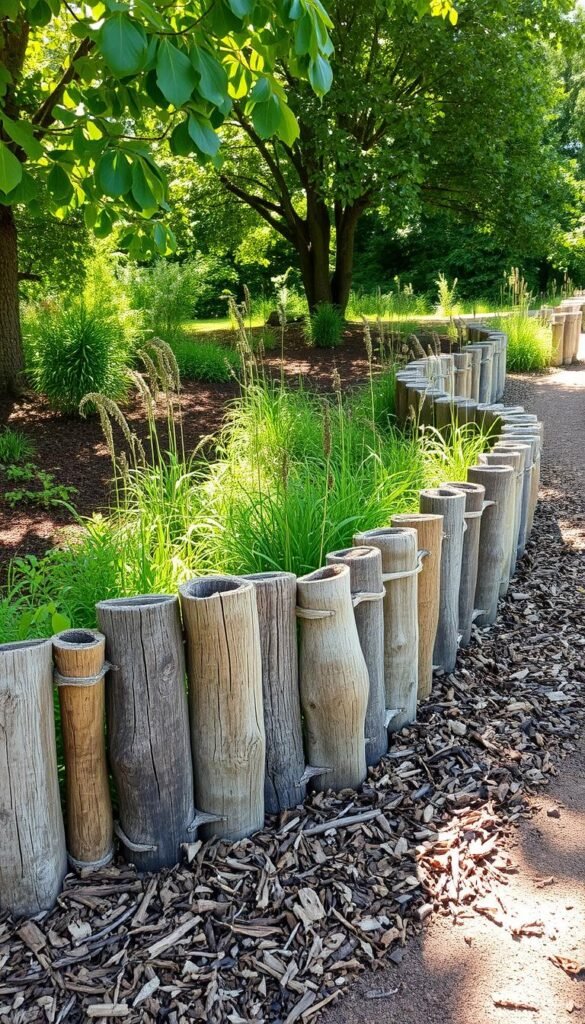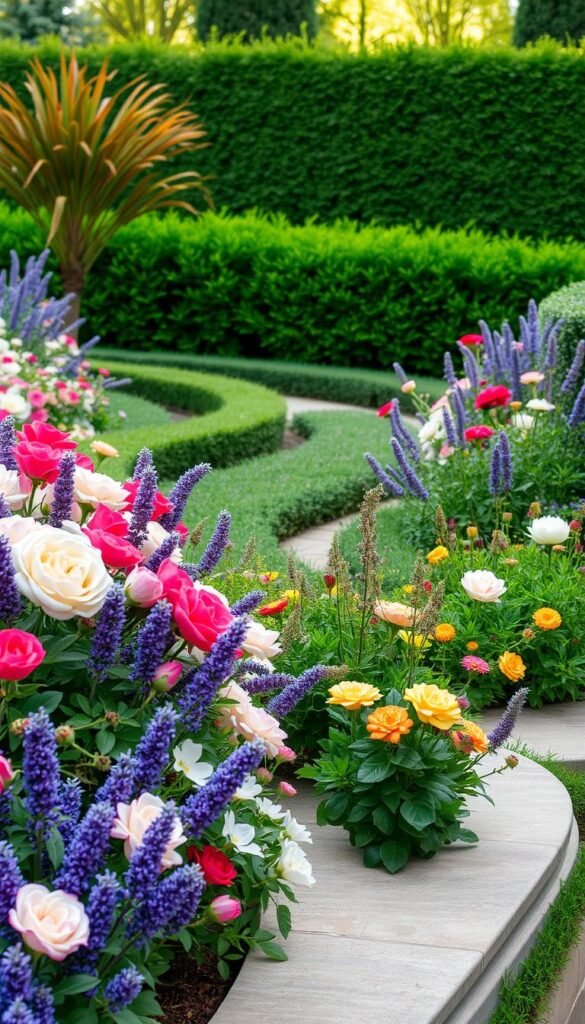Well-maintained edges give your yard structure while boosting its visual appeal. These practical features keep plants contained and walkways clear, creating clean divisions between flower beds, lawns, and hardscapes. With smart edging choices, you’ll add both function and personality to your property.
Modern landscape design offers endless possibilities for defining spaces. From rustic natural stone to sleek metal strips, materials range from budget-friendly to premium. Each option brings unique texture and style to your outdoor areas while controlling grass spread.
Thoughtful border installations make gardens look professionally maintained. They highlight your favorite plants and create focal points that draw the eye. Even simple updates like curved paver lines can dramatically upgrade your home’s curb appeal.
Discover how the right edging solutions blend practicality with artistry. We’ll explore durable materials, installation tips, and creative approaches that fit various yards and budgets. Let’s turn your outdoor space into a cohesive, inviting retreat that reflects your personal taste.
Introduction to Elegant Garden Borders

Imagine your garden as a canvas, with edging providing the clean lines that highlight its beauty. These boundaries do more than look pretty—they keep mulch in place, stop grass invasions, and create crisp transitions between your lawn and flower beds. A thoughtful garden edging strategy turns chaotic greenery into organized artistry.
You’ll love how borders simplify maintenance while boosting curb appeal. They prevent soil erosion along pathways and give your landscape design intentional structure. Whether using stone, metal, or recycled materials, the right choice adds personality to your outdoor space without breaking the bank.
Here’s why smart edging matters:
- Defines planting zones clearly for visual harmony
- Reduces weekly yard work by containing growth
- Adds subtle texture that complements your home’s style
Looking for inspiration? Explore creative garden edging ideas that balance form and function. Even simple updates like staggered bricks or corten steel strips can make your property look professionally designed. The secret lies in choosing materials that withstand weather while matching your garden’s vibe.
Your landscape deserves borders that work as hard as they shine. With strategic placement and durable materials, you’ll create lasting beauty that impresses guests and simplifies seasonal chores.
Understanding the Role of Garden Edging in Your Landscape

Edging serves as the backbone of your landscape’s visual story. It shapes how people experience your outdoor space, guiding eyes toward blooms while keeping walkways tidy. Think of it as invisible hands that organize your garden into purposeful zones.
Smart edging creates clear boundaries between your lawn and flower beds. This stops grass roots from sneaking into planting areas. You’ll spend less time weeding and more time enjoying crisp lines that make shrubs pop.
Different materials bring unique perks. Metal strips offer sleek modernity, while weathered stones add rustic charm. Your choice should mirror your home’s design language while standing up to local weather.
| Material | Key Benefit | Maintenance |
|---|---|---|
| Stone | Natural look | Low |
| Metal | Clean lines | Moderate |
| Plastic | Budget-friendly | High |
Zoning becomes effortless with strategic placement. Separate vegetable patches from lounging areas using subtle dividers. This functional artistry makes your entire landscape feel intentional and polished.
Remember: good garden edging works quietly but makes a loud impact. It’s the difference between “nice yard” and “wow, who designed this?” Choose materials that balance durability with personality for lasting appeal.
10 Elegant Garden Border Ideas to Enhance Your Landscape

Transform your outdoor areas with borders that blend beauty and purpose. Discover ten approaches that turn functional edging into artistic statements, from upcycled treasures to sleek modern designs. Each solution adapts to different budgets while elevating your landscape’s character.
Mix textures for unexpected charm. Try pairing smooth river rocks with rough-cut timber, or contrast powder-coated metal strips with wildflowers. These combinations create depth while serving as practical dividers between lawn and planting zones.
Climate plays a crucial role in material success. Metal works well in dry regions, while stone resists frost heave in colder areas. For humid climates, consider building raised beds with integrated borders that improve drainage and soil quality.
Height variations add drama to flat spaces. Low-profile bricks keep sightlines open, while taller stacked slate creates intimate garden rooms. Use color strategically—dark materials recede visually, making small yards feel larger.
Professional designers often layer elements for impact. Combine a primary border with secondary ground covers like creeping thyme. This technique adds polish while suppressing weeds naturally. Remember: the best garden edges balance your lifestyle needs with visual harmony.
Embracing Natural Materials: Stone, Brick, and More

Natural materials bring earth’s artistry to your landscape design. Stone and brick edging offer organic textures that blend seamlessly with outdoor environments. These classic choices adapt to modern and traditional spaces alike, creating boundaries that feel both intentional and harmonious.
Benefits of Stone and Brick Edging
Brick’s uniform shape makes it perfect for crisp geometric patterns. You can lay them vertically for height or horizontally for subtle definition. Weather-resistant varieties like clay or concrete bricks withstand freeze-thaw cycles, keeping edges sharp for decades.
Natural stones like limestone and granite bring rugged charm. Their irregular shapes create mosaic-like borders that complement cottage gardens or woodland settings. Unlike synthetic materials, they develop a mossy patina that enhances their natural look over time.
| Material | Best Use Cases | Maintenance |
|---|---|---|
| Brick | Geometric designs | Annual scrubbing |
| Flagstone | Curved pathways | Weed barrier checks |
| Fieldstone | Rustic borders | None |
Creating Curved and Defined Lines
Flexible brick layouts let you craft gentle arcs around flower beds. Bury bricks halfway into soil at angles to form smooth curves. For stone edging, use smaller rocks to fill gaps between larger pieces—this technique maintains flow while preventing soil spillage.
Pair materials strategically. Combine brick corners with stone straightaways for visual interest. Match colors to your home’s exterior: reddish bricks echo terracotta roofs, while gray stones complement modern concrete facades. These connections make your entire garden feel thoughtfully designed.
Proper installation ensures longevity. Dig a 4-inch trench, add gravel base, and set materials tightly. This foundation prevents shifting and keeps edges crisp through seasons. With minimal care, your natural borders will frame plantings beautifully for years.
Exploring Metal and Plastic Edging Solutions

Modern landscapes demand solutions that marry durability with design. Metal and plastic edging offer distinct advantages for creating crisp boundaries that endure seasons. While plastic provides budget-friendly flexibility, metal delivers sleek sophistication—both serving as practical garden workhorses.
Durability Meets Contemporary Style
Today’s metal edging options elevate outdoor spaces with powder-coated finishes and rust-resistant alloys. Aluminum strips maintain sharp lines for decades, while corten steel develops a warm patina over years. These materials withstand string trimmers and foot traffic without bending or fading.
Simplified Setup for Plastic Systems
Modern plastic edging surprises with textured designs mimicking wrought iron or stone. Flexible coils adapt to curves, and UV-stable colors won’t wash out. For easy install, follow these steps:
- Dig a 3-inch trench along your planned route
- Secure sections with included stakes every 18 inches
- Backfill soil to hide the upper lip
| Material | Best For | Lifespan | Installation |
|---|---|---|---|
| Metal | High-impact areas | 15+ years | Hammer-in spikes |
| Plastic | Curved beds | 8-10 years | Trench & stake |
Combine both materials strategically. Use metal near patios for crisp edges, and plastic around delicate perennials where flexibility matters. This hybrid approach balances cost and visual impact across your garden zones.
Creative Wood and Mulch Border Alternatives

Wooden borders bring warmth to your outdoor spaces while defining planting zones with earthy charm. Cedar and redwood stand out for their natural rot resistance, lasting years without chemical treatments. Eucalyptus adds coastal flair in warm climates, its silver-gray patina blending beautifully with tropical foliage.
Pair wood edging with mulch for layered functionality. The timber acts as a retaining wall for bark chips or cocoa shells, preventing spread while enriching soil. This combo creates tidy transitions between lawn areas and flower beds.
Installation proves simple for DIYers. Most wood materials require just:
- A rubber mallet to secure stakes
- Level ground preparation
- Spacing planks 1/8″ apart for expansion
Climate dictates your best options. Cedar thrives in humid regions, while pressure-treated lumber withstands Midwest winters. For free rustic charm, upcycle fallen logs as curving garden borders—just seal cut ends with wood preservative.
Extend your edging‘s lifespan through smart care. Elevate wood 1/2″ above soil to prevent rot, and refresh protective sealant every two years. These steps maintain structural integrity while letting the material age gracefully alongside your plants.
Budget-Friendly and Easy-to-Install Edging Options
Great edges don’t need to drain your wallet or weekend. You can achieve polished results using simple techniques and clever material choices. Even basic approaches keep your garden looking sharp while saving time and money.
Smart Solutions for Thrifty Spaces
Try hand-cutting borders with an edging shovel for instant definition. This option costs nothing but elbow grease. While it needs yearly refreshing, the crisp lines make flower beds pop against your lawn.
Prefer something more permanent? Pound-in plastic strips offer easy install in under an hour. Modern versions mimic pricier materials like wrought iron. They stay put for years with minimal upkeep.
Upcycle everyday items for unique charm. Old wine bottles buried neck-down create playful borders. Scrap wood or salvaged bricks work beautifully when sealed properly. These space-saving tricks turn clutter into functional art.
Your garden deserves definition without complexity. Choose solutions matching your schedule and skills. With smart picks, you’ll craft edges that impress guests and simplify maintenance in one weekend.






